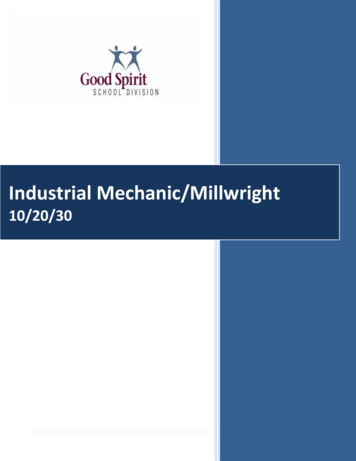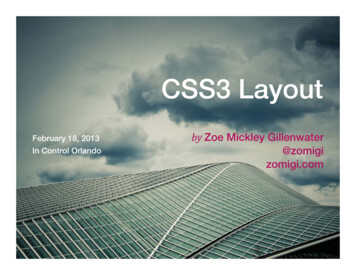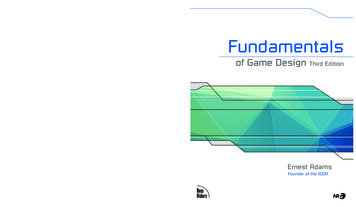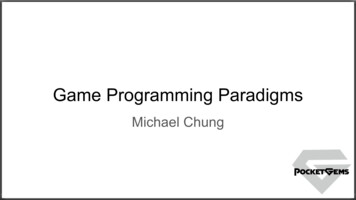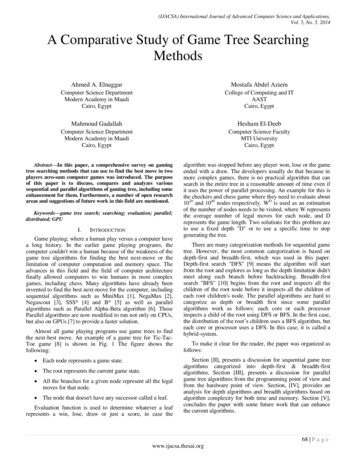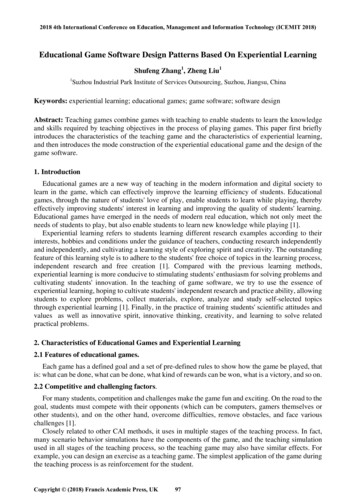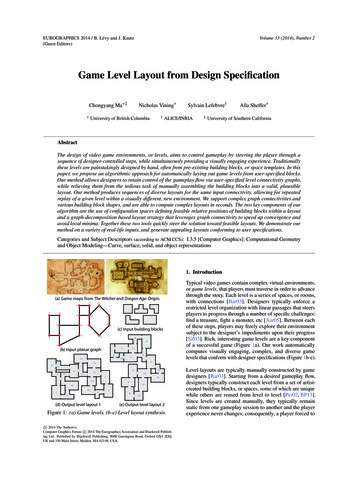
Transcription
EUROGRAPHICS 2014 / B. Lévy and J. Kautz(Guest Editors)Volume 33 (2014), Number 2Game Level Layout from Design SpecificationChongyang Ma ‡ Nicholas Vining †University of British ColumbiaSylvain Lefebvre†ALICE/INRIA‡Alla Sheffer University of Southern CaliforniaAbstractThe design of video game environments, or levels, aims to control gameplay by steering the player through asequence of designer-controlled steps, while simultaneously providing a visually engaging experience. Traditionallythese levels are painstakingly designed by hand, often from pre-existing building blocks, or space templates. In thispaper, we propose an algorithmic approach for automatically laying out game levels from user-specified blocks.Our method allows designers to retain control of the gameplay flow via user-specified level connectivity graphs,while relieving them from the tedious task of manually assembling the building blocks into a valid, plausiblelayout. Our method produces sequences of diverse layouts for the same input connectivity, allowing for repeatedreplay of a given level within a visually different, new environment. We support complex graph connectivities andvarious building block shapes, and are able to compute complex layouts in seconds. The two key components of ouralgorithm are the use of configuration spaces defining feasible relative positions of building blocks within a layoutand a graph-decomposition based layout strategy that leverages graph connectivity to speed up convergence andavoid local minima. Together these two tools quickly steer the solution toward feasible layouts. We demonstrate ourmethod on a variety of real-life inputs, and generate appealing layouts conforming to user specifications.Categories and Subject Descriptors (according to ACM CCS): I.3.5 [Computer Graphics]: Computational Geometryand Object Modeling—Curve, surface, solid, and object representations1. Introduction(a) Game maps from The Witcher and Dragon Age: Origin.151491011512621161387(c) Input building blocks34030(b) Input planar graph12965101411150Typical video games contain complex virtual environments,or game levels, that players must traverse in order to advancethrough the story. Each level is a series of spaces, or rooms,with connections [Bar03]. Designers typically enforce arestricted level organization with linear passages that steersplayers to progress through a number of specific challenges:find a treasure, fight a monster, etc [Aar05]. Between eachof these steps, players may freely explore their environmentsubject to the designer’s impediments upon their progress[SZ03]. Rich, interesting game levels are a key componentof a successful game (Figure 1a). Our work automaticallycomputes visually engaging, complex, and diverse gamelevels that conform with designer specifications (Figure 1b-e).3621471211512715164161013189(d) Output level layout 14813(e) Output level layout 2Figure 1: (a) Game levels. (b-e) Level layout synthesis.c 2014 The Author(s)Computer Graphics Forum c 2014 The Eurographics Association and Blackwell Publishing Ltd. Published by Blackwell Publishing, 9600 Garsington Road, Oxford OX4 2DQ,UK and 350 Main Street, Malden, MA 02148, USA.Level layouts are typically manually constructed by gamedesigners [Bar03]. Starting from a desired gameplay flow,designers typically construct each level from a set of artistcreated building blocks, or spaces, some of which are uniquewhile others are reused from level to level [Per02, BP13].Since levels are created manually, they typically remainstatic from one gameplay session to another and the playerexperience never changes; consequently, a player forced to
C Ma, N Vining, S Lefebvre, & A Sheffer / Game Level Layout from Design Specificationreplay a level repeatedly experiences what is referred to as‘grinding’. Some games (e.g. so-called ‘roguelikes’) offerrandomly generated levels, but the cost of random levelgeneration is that designer control is lost and they can nolonger steer the flow of gameplay [Cra04].We propose a novel approach for game level layout generation, capable of automatically producing a variety of distinctgame levels for replay while still allowing the designer todefine the flow of gameplay. The input to our method consistsof a planar connectivity graph that reflects the designerintended gameplay flow (Figure 1b) and a set of polygonalbuilding blocks (Figure 1c). Each graph node corresponds toa space, or room, in the desired layout, and the edges definethe connectivity between them. We use the graph to assemblethe building blocks into diverse possible layouts which satisfythe gameplay-flow encoded by the graph (Figure 1d,e).The technical challenge we face is to layout the blocks suchthat two key constraints are satisfied: the layout must beintersection-free, i.e. we require that blocks within each leveldo not overlap, and must also satisfy all pairwise contacts each pair of blocks connected by a graph edge must share aboundary segment long enough to place a doorway through.The interplay between the need to move blocks together toenforce contacts and the need to keep them apart to avoidintersections make game level layout a challenging problem,distinct from those addressed in other contexts (Section 2).To obtain layouts that satisfy these constraints we develop anoptimization strategy that leverages two geometry processingtools. First, we exploit graph connectivity to design a divideand-conquer layout strategy, speeding up convergence to validsolutions. Second, instead of exploring the set of all possiblebuilding block positions, our algorithm considers reduced,continuous configuration spaces [LP83] defined for pairs ofadjacent blocks. We use these configuration spaces to quicklyevaluate contacts and to instantaneously improve them forindividual blocks. We use these two ingredients to efficientlyexplore the solution space using a stochastic optimizationprocess. We leverage partial solution caching to facilitatequick, on demand, generation of new distinct levels from thesame graph whenever a player repeats a given level.Our contribution is two-fold. We introduce the first gamelevel layout algorithm for general 3D maps that provideshigh-level designer-control of gameflow while enabling theuse of existing game building blocks. Our algorithm supportscomplex planar graph layouts, including graphs with multipleinterconnected cycles that are common in game design, andarbitrarily shaped polygonal building blocks. Designers canenforce additional requirements on the generated levels,such as associating graph nodes with particular blocksand specifying appropriately connected multi-floor layouts(Section 4). Our algorithm can easily be integrated intoexisting game development workflows, and is suitable for awide range of genres. Our technical contribution is a practicalsolution to a challenging layout problem, variants of whichhad been shown to be PSPACE-complete [HSS84]. Ourexperiments have shown our algorithm to robustly handlea large spectrum of typical game layout inputs (Section 4).2. Background and Related WorkIndustry Practices. Virtual worlds in games can be decomposed into a series of areas or levels [Bar03, Aar05, HC12,Ash11], Figure 1a. Games often include hundreds of levels,each typically containing up to a few dozen connectedspaces [Bar03, Aar05]. Game designers use the connectivitybetween the spaces to control the flow of gameplay andto tell a compelling story [Cra04, Bar03, SZ03]. In typicalgame design, each level is constructed by hand, in a timeconsuming and repetitive process. A widespread industrypractice [Per02, BP13] is to create a set of templates, orbuilding blocks, defining possible space shapes, and thenreuse those multiple times when assembling a level. Thisapproach allows for easy assembly of the final 3D realizationsof the layouts. These practices guide our choice of user input a graph defining the space connectivity and a set of 2D spacetemplates or building blocks.Automating Level Generation. Shaker et al. [STN14]discuss three methods for level generation. Recursive spatialpartitioning is commonly used for architectural floorplan layouts and is not suitable for arbitrary game levels (see below).Agent-based layout methods, such as the one employed byDungeons of Dredmor [Gas11], connect building blocks toeach other using a greedy strategy that maintains a queue of“open positions” where a new door connecting two spacescan be placed. To ensure contact and avoid intersections theyhandle only acyclical layouts and use blocks quantized toand aligned with a fixed grid. Methods inspired by cellularautomata [JYT10, ALM11] generate 2D layouts for organicenvironments such as caves and do not support the predefinedblocks used to quickly assemble 3D levels.Academic Research. The computer graphics communityhas so far focused on placement of objects within levels.e.g. [YYW 12] which places sand, water traps and holes onvirtual golf courses, or on automatically adapting buildingblocks extracted from game levels [CLDD09], and has notaddressed actual level layout. The artificial and computationalintelligence community also investigates level design; see[TYSB11] for a comprehensive survey. The focus is ondesigning engaging level structures, or quest graphs. This iscomplementary to our goal as the generated quest graphs canserve as inputs to our method. A number of approaches produce levels for two-dimensional "side-scroller" environments[STY 11], in which the X direction represents "progress" andthe "Y" direction represents vertical movement; we solve theharder problem of generating two-dimensional floorplans for3D levels, with "progress" described by an arbitrary planargraph.Graph Drawing. 2D planar graph drawing aims to generate intersection-free layouts of graphs that satisfy specificuser requirements [NR04]. Level layout requires placinga polygonal building block at each vertex such that theblocks do not intersect and such that each pair of blockscorresponding to adjacent graph vertices share a commonboundary segment. While it is easy to extend traditionalgraph-drawing algorithms to generate intersection-free blockc 2014 The Author(s)c 2014 The Eurographics Association and Blackwell Publishing Ltd.
C Ma, N Vining, S Lefebvre, & A Sheffer / Game Level Layout from Design Specificationlayouts (one can simply scale a 2D graph embedding till theblocks associated with each vertex no longer touch), it is therequirement for contact that makes our problem significantlyharder. To the best of our knowledge this constraint had notbeen addressed before in the graph drawing community.Procedural Geometry Layout. A variety of proceduralmethods have been successfully used for the design ofcities [PM01, MM08, CEW 08, VKW 12] and buildings[WWSR03, MWH 06, LCOZ 11]. These approaches focuson the plausibility and aesthetics of the outputs, and do notaim to control contacts or adjacencies between individualbuildings or interior spaces.Floorplan Layout. Our work has strong links to the generation of floorplans for architectural spaces, also knownas the spatial allocation problem [MS74, Sha87, Lig00, MSK10, LYAM13, BYMW13]. As research in this area hasfocused on real-world architectural spaces, floorplans aretypically generated for predefined envelopes, rooms arecomposed of axis-aligned walls, and no unoccupied voidsare allowed between rooms. The main degree of freedom inthis setting comes from the ability to scale rooms in the axialdirections and to relax contact constraints. Contrary to theseexpectations, in a game setup we require the outputs to strictlysatisfy contacts and operate on user-specified arbitrarilyshaped polygonal building blocks. At the same time, we haveno constraints on envelope shapes or on the location of voids.In fact, flexible envelopes and interior voids are often used toadd visual interest to game levels (Figure 1a) and make thelayout feasible even for complex user-specified space graphs.VLSI Layout. Our problem has some similarity to VLSIcircuit layout [She98]. VLSI layout algorithms search for thebest placement of axis-aligned cells and wires connectingthem on a compact chip such that wire length is minimizedand crossovers are avoided. This layout problem is knownto be NP-complete, and algorithms for solving it focus ongenerating the best solution with considerable computationaleffort; our work concentrates on quickly providing multipleand varied layouts of differently shaped blocks strictlysatisfying contacts, modifying the layout envelope at will.Configuration Spaces. In motion planning for robotics, theconfiguration space of an object is the set of all possibletransformations that can be applied to the object whileavoiding intersections with other objects [LP83, LaV06].Operating on the space of transformations converts complexgeometric problems into simpler ones by spatial collapse. Weuse configuration spaces to assist in our space layout by formulating contacts and intersection avoidance as restrictionson configuration spaces. It has been observed that the generalconfiguration space form of our layout problem, expressedsolely for rectangular regions in a rectangular envelope, isPSPACE-complete [HSS84].3D Game Levels. 2D game levels and floorplans can beconverted into 3D architectural structures using a varietyof methods [YWR09, KW11, MM08]. Given a game levellayout assembled from a finite set of building blocks, Cabralet al [CLDD09] generate seamless 3D levels by deforming thec 2014 The Author(s)c 2014 The Eurographics Association and Blackwell Publishing Ltd.Figure 2: Configuration spaces. Left: Configuration space(red) of the square block (dark) with respect to the L-shaped(light) one defines all the locations of the center of the squarein which the two blocks are in contact and do not intersect.Right: Intersection of configuration spaces (yellow dots) ofthe moving dark block with respect to the two light ones.Pairwise configuration spaces shown in red.blocks to match openings and appropriately resizing corridors,doors and stairs. Our outputs can directly be used as the inputto their method.3. AlgorithmOur method takes a planar graph and a set of 2D polygonalbuilding blocks as input data and generate various corresponding valid level layouts by arranging the blocks such that eachgraph node corresponds to an admissible building block, notwo blocks intersect, and each pair of blocks correspondingto adjacent graph nodes share a common boundary segment(see Figures 1 and 3).Combined together, these requirements define a highdimensional, mixed continuous-discrete problem, where thecontinuous degrees of freedom are the block positions and thediscrete ones are the node-to-block associations. A standardapproach to such mixed problems would be to define anenergy term encapsulating our requirements, and then toattempt to find a layout that minimizes this energy term usingstate-of-the-art stochastic optimization. However, naivelydoing so fails to take advantage of domain specific knowledge.Instead we use a tailored solution mechanism that leverageskey level layout properties to quickly generate diverse layoutswith high convergence rates. We compare our solution tomore standard approaches in Section 4.We first note that given a layout where all but one node’sblocks and positions are fixed, we can directly compute the setof positions for the free node that best satisfy our constraintslocally (i.e. with respect to its adjacent graph nodes) bycomputing the configuration space [LP83] of the blockassociated with this node with respect to the neighboringblocks (Section 3.1, Figure 2). Given a building block shapeassociated with the node, this configuration space definesa (possibly empty) set of line segments or points, such thatplacing the center of the block at any point in the space locallysatisfies contacts and ensures that no local intersectionsoccur (Figure 2). We cannot formulate the entire level layoutproblem solely as a configuration space computation, aseven a restricted version of such a computation is PSPACEhard [HSS84]. Using local configuration spaces within a
C Ma, N Vining, S Lefebvre, & A Sheffer / Game Level Layout from Design Specificationrandomized optimization setup (Section 3.3), however, notonly lets us drastically speed up convergence but also supportsour variability goal as placing a block at any location insidethe configuration space locally satisfies our constraints.0134Our basic algorithm can be extended to support a numberof features desired by game level designers, showcased inSection 4. These include fixed or restricted building blocks,rotation and scaling of rooms, fixed positions, and multiplefloor layout generation. In particular we automatically enrichinput building block sets by precomputing scaled and rotatedvariations of the basic blocks, then allowing the optimizer toselect them as new blocks.3.1. Configuration SpaceIn general, finding a high-dimensional configuration ofobjects that satisfies a set of hard non-linear constraintsis known to be a difficult problem. However, we observethat for level layouts we can use geometric tools to directlycompute local solution spaces, such that positioning a blockinside these spaces best satisfies both intersection and contactconstraints for this block with respect to its immediateneighbors in the input graph. Specifically given a pair ofblocks, one fixed and one free, this set of valid positions is aunion of 1D line segments and can be computed analytically(Figure 2, left). By leveraging these valid position sets, whichin robotics literature are referred to as configuration spaces[LP83, LaV06], we dramatically reduce the size of the spacethat we must search.We compute the configuration space for a pair of blocks, oneof which is fixed and the other one of which is allowed tomove, as follows. We fix a reference point on the movingblock, e.g. its center, and consider all locations in R2 suchthat, if the moving block is translated so that our reference10121(d) Full solution 1613673304064784785(b) Partial solution 1 (c) Partial solution 206448(a) Input graph43573306A classical approach for speeding up optimization in highdimensional spaces is to reduce dimensionality by breaking the input problem into smaller easier to solve subproblems, appropriately communicating constraints betweensub-problem solves. Following this strategy, we break thelayout problem into a set of smaller ones, where at eachstep we only process a portion of the input graph, thusreducing the dimension of the search space (Section 3.2).Our challenge is to appropriately define these subgraphs andthe communication strategy. A standard divide-and-conquerapproach would recursively split the problem into equalsmaller subgraphs, performing a bottom-up merge of partialsolutions. However, this leads to merging two large partialsolutions together, an operation as difficult as laying outthe entire graph at once. We instead propose an incrementalprocessing order, adding sequences of blocks (chains) to apartial solution. The added chains have roughly the samecomplexity, preventing the problem from growing out ofproportion. We ensure that the generated partial layouts areboth valid and connected at all times, increasing the odds thatthey can be extended into valid full layouts of the entire inputgraph. Our control mechanism allows for backtracking in therare cases that this extension process fails.02125178(e) Full solution 2552(f ) Full solution 382(g) Full solution 4Figure 3: Incremental level layout. Here (b) and (c) showtwo partial solutions after laying out the first chain; (d) and(e) show two full solutions after extending the partial layoutin (b) to include the second chain; (f) and (g) show two fulllayouts extending the partial layout in (c).point is placed at this location, the stationary block andthe moving block contact each other but do not intersect.Note that in order for two polygons to contact each otheralong a non-zero length segment, allowing for a doorwaybetween them, they must touch along a common paralleledge. As the moving block slides along this edge, the fixedpoint on the moving block traces a line segment in Euclideanspace. Repeating this process for every pair of parallel edgeson the two blocks yields a collection of line segments, theconfiguration space of the two blocks (Figure 2, left). Foreach pair of parallel edges these segments can be computedefficiently using any number of geometric computing engines.The configuration space of a moving block with respect totwo or more stationary ones, is simply the intersection of theindividual configuration spaces placing the moving block invalid contact with each of its neighbors - or, in other words,the intersection of collections of line segments (Figure 2,right). These are usually points, but can be line segments ifthe block can contact both of its neighbors along two parallelor collinear edges.Since our block geometry is fixed during optimization weprecompute the configuration space for each pair of blockshapes, facilitating quicker processing later on.3.2. Incremental LayoutConfiguration spaces let us dramatically reduce the localsearch spaces for individual graph nodes; however, the overallsearch space we consider remains too large for a solution to belocated reliably, within a practical amount of time. To speedup processing we break the layout problem into, smaller,easier to solve ones. We note that chains, or graphs whereeach node has at most two neighbors, are relatively easy tolay out as the number of local contact constraints is alwayssmaller than the number of block edges. Since a game layoutis dominated by linear progression, we anticipate our inputgraphs to be dominated by a small set of long chains. Wec 2014 The Author(s)c 2014 The Eurographics Association and Blackwell Publishing Ltd.
C Ma, N Vining, S Lefebvre, & A Sheffer / Game Level Layout from Design Specificationdecompose our input graphs into chains, as described below,taking particular care to address graphs with cycles where thelayout is more constrained.Given a set of chains, we recall that our final output layouthas to be a single connected component; hence there is nobenefit in processing chains independently and then trying tojoin them into a single layout. We therefore process the set ofchains incrementally (Pseudocode 1) using their adjacenciesto guide us. We first compute a set of possible layouts forone chain, and then extend these partial layouts by addingneighboring chains, i.e. those sharing graph edges with thepartial layout, one at a time, generating multiple extendedlayouts and storing them. The process terminates once allchains are processed and a sufficient number of layouts forthe entire input graph have been found, or when no moredistinct layouts can be computed. If an extension step fails,we backtrack to the last previously computed and storedpartial layout and continue the extension process from it. Anextension typically fails if the partial layout it starts fromsurrounds the blocks that need to come into contact with thenew chain (Figure 4). The goal of generating multiple partiallayouts instead of just one is twofold. First, we increase thelikelihood that at least one of these layouts can be extendedto a full layout, i.e. a layout of the entire graph. Second, bypre-caching partial layouts we facilitate quick, on-demand,creation of additional full layouts.Pseudocode 1 Incremental level layoutInput: Planar graph G, building blocks B, layout stack S1: procedure I NCREMENTAL L AYOUT(G, B, S)2:Push empty layout into S3:repeat4:s S.pop()5:Get the next chain c to add to s6:AddChain(c, s) //extend the layout to contain c7:if extended partial layouts were generated then8:Push new partial layouts into S9:end if10:until target # of full layouts is generated or S is empty11: end procedureOur strategy when decomposing the graph into chains andwhen deciding on chain processing order is guided by twofactors. First, we observe that cyclical chains are significantlymore constrained than open-ended ones, as in the formercase the blocks must form a cycle, with the last and first onestouching one another. We first decompose the input graph intoa set of cycles and trees, using a planar embedding of the inputgraph generated using a standard algorithm [CP89], then findall the faces in the embedding. This embedding serves onlyfor decomposition into chains and chain ordering, and thepositions are discarded. We form the first chain using theedges of the face with the minimum number of edges in theembedding. We then iteratively consider neighbouring planarfaces, picking a face and grouping all edges on that face thatare not already in a cycle into a new cycle. Given multipleneighboring chains we select the shorter ones first. We repeatthe process until all faces are processed. The remainingc 2014 The Author(s)c 2014 The Eurographics Association and Blackwell Publishing Ltd.34567712624908015118931012101211(a) Input graph1314(b) A bad partial layout7647622413959015831401108103111112(c) A good partial layout after backtracking12(d) Final solutionFigure 4: A partial layout (b) of the input graph in (a) cannotbe easily extended – rooms 13 and 14 cannot reach room 9.Backtracking to a different partial layout (c) facilitates a fulllayout generation (d).acylical graph components are then processed in a breadthfirst order. The incremental layout processes the chains increation order (Pseudocode 1). Our motivation for trying toplace smaller cycles before larger cycles whenever possibleis that small cycles impose less constraints on subsequentextension then larger ones. The breadth-first-order is chosendue to similar considerations.3.3. Chain LayoutThe goal of the chain layout step is to extend a, possiblyempty, valid partial layout to include an additional chainthat is connected to this layout via one or more graph edges(Figures 5 and 3). In other words, we need to find blocksand positions for the nodes of the added chain such that theextended layout is valid. To assist the layout of this new chain,we allow changes to the input partial layout, but keep theprobability of those low. As earlier noted, instead of searchingfor one extended layout, we need to search for multiple onesto increase the chances of success in subsequent iterations ofthe chain-by-chain layout process.To achieve this goal we use a simulated annealing framework,as its built-in randomization process is, in our experience,especially well suited for exploring multiple solution alternatives (Pseudocode 2). Simulated annealing operatesby iteratively considering local perturbations to the currentconfiguration, or layout, and moving to these configurationswith some probability based on the energy of each new configuration and the current annealing temperature. Configurationsthat lower the energy have a higher probability of acceptance.As it proceeds, it keeps track of the best solution encountered,or, in our case, of the different valid layouts encountered.Energy Function. Our energy function is designed to heavilypenalize both intersections and missing contacts, and usesexponential terms designed to drop dramatically whenever
C Ma, N Vining, S Lefebvre, & A Sheffer / Game Level Layout from Design Specification0152566353(a) Input graph4(b) 7632210(c) Intermediate result 1 (d) Intermediate result 2 (e) Intermediate result 3 (f ) Intermediate result 410(g) Final outputFigure 5: Chain layout. While some updates, e.g. (f) to (g) lower the energy, others support exploring the configuration space byaccepting states that keep the energy constant or even increase it, e.g. (c) to (d).Pseudocode 2 Extend partial layout s adding the chain c1: procedure A DD C HAIN(G, B, S, c, s)2:t t0// Initial temperature3:for i 1, n do// n: # of cycles in total4:for j 1, m do// m: # of trials per cycle5:s0 Locally perturb s c6:if s0 is valid then7:if s c is full layout then output it8:else if s0 passes variability test9:Push s0 into SReturn if enough extended layouts computed10:11:end if12:end if13:if E 0 then// E E(s0 ) E(s)14:s s015:else if rand() e E/(k t) then16:s s017:else18:Discard s019:end if20:end for21:t t ratio// Cool down temperature22:end for23: end procedurean intersection is removed or a contact is achieved.ADE eσ ·eσ 1(1)A is the total area of intersection between two blocks in thelayout and D is the sum of squared distances between thecenter of pairs of blocks that are connected in the extendedsubgraph, but which are not in contact (or share a segmentshorter than the user specified doorway width). The choice ofσ impacts how frequently the annealing is allowed to move tohigher-energy configuration. A smaller value of σ producesa higher success ratio, and a larger value of σ producesa quicker convergence. Empirically we found that settingσ to one hundred times the average block area provides areasonable trade-off between the two.Initialization. To speed up processing we aim to start theannealing in a low energy configuration. To this end, wegenerate a BFS ordering of the chain blocks starting withthose adjacent to the input partial layout if one exists, or witha random root block otherwise. We place the blocks one at atime, sampling their configuration space with respect to theiralready laid out neighbors and selecting the sampled positionwith the lowest energy.Local Perturbation. We perturb the current layout bychanging the block position, or the node-to-block association,of one node in the extended graph containing both the nodescorresponding to the input partial layout and those of thecurrently processed chain. When deciding on the node toperturb, we only consider nodes in the currently addedchain and nodes in the previous layout with non-zero energy(thus minimally perturbing the input partial layout). In ourimplementation, we set the ratio of position perturbati
game design, each level is constructed by hand, in a time-consuming and repetitive process. A widespread industry practice [Per02,BP13] is to create a set of templates, or building blocks, defining possible space shapes

